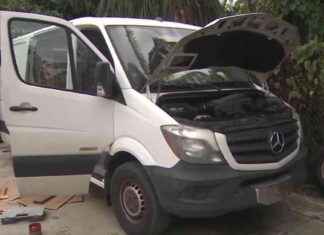Indeed, the missile that forced Japan on Thursday to activate refuge alerts for the population of the island of Hokkaido is a solid fuel intercontinental ballistic missile (ICBM), as some experts predicted yesterday. North Korean leader Kim Jong Un confirmed this and christened it the Hwasong-18, a weapon that can theoretically hit the US and is much more efficient and difficult to detect compared to long-range projectiles that Pyongyang had until now.
Kim oversaw the test, warning that knowledge of the weapon’s existence in North Korean hands would make enemies “experience a clearer security crisis, constantly instilling in them extreme unease and horror by taking fatal and offensive countermeasures until they give up.” his mindless thinking and reckless acts.”
To make the announcement, the North Korean leader posed with his daughter, whose age remains a mystery although South Korean intelligence sources point to the age of 10, in several photographs taken at the launch site of the ballistic test. It was the third time that the little girl accompanied her father in the launch of an ICBM.
The missile does not require the lengthy pre-launch propellant loading process necessary for liquid-fueled projectiles, which exposes them to a possible pre-emptive attack by the enemy for a longer period of time.
Storage, deployment and operation are easier and more effective with the Hwasong-18 compared to the ICBMs that Pyongyang has been unveiling since 2017 (Hwasong-14, 15 and 17) and with which it could theoretically already reach the entire US territory and the almost the entire planet, with the exception of South America.
This new ICBM is an important stepping stone when it comes to increasing the variety and sophistication of an arsenal that makes it practically impossible to try to attack North Korean territory without triggering a retaliation from the Kim Jong Un regime that costs many lives.
Kim himself, who said that the weapon “will improve the country’s nuclear counterattack capacity”, yesterday witnessed the launch in the company of, in addition to his daughter, his wife, his sister, members of the Presidium of the Central Committee of the single party and some one of the main figures in the national arms program, according to the state news agency KCNA.
“The objective of the test launch was to confirm the performance of high-propulsion solid-fuel engines for multi-stage missiles and the reliability of their separation and various functional control systems, and to estimate the military use of this new strategic weapon,” added KCNA, which published images of the correct separation of the three phases of the missile.
The development of a solid fuel ICBM has long been seen as a key goal for North Korea, as it could help the North deploy missiles faster during a war.
On Thursday, the South Korean military reported that it detected the launch of a medium- or long-range ballistic missile from the vicinity of Pyongyang and that the projectile traveled about 1,000 kilometers before falling into the waters of the Sea of ​​Japan (called the East Sea in the two Koreas).
Japanese radars captured the launch and estimated a trajectory that indicated a potential impact around the northern island of Hokkaido, so the authorities decided to activate the citizen alert despite the fact that the missile disappeared after the screens and ended up falling somewhere undetermined from the Sea of ​​Japan, outside the Japanese exclusive economic zone.
This would be explained by the fact that, as KCNA explains, the North Korean army established a standard ballistic trajectory for the first phase of the missile and a vertical one for the other two, which caused the Hwasong-18 to draw a parabola first and then then he would fly up perpendicular.
At the same time, it is striking that North Korea has developed and tested a solid fuel ICBM less than six years after testing its first equivalent liquid fuel missile, an interval that was more than doubled in the case of giants. such as China (19 years) or India (13 years).
Developing a solid fuel ICBM was one of the objectives set out in the five-year weapons modernization plan approved by the regime in January 2021.
Without the halfway point of that five-year period yet having been completed, of the dozen new systems to be developed proposed in that plan, five, including the Hwasong-18, have already been tested while one of them -the nuclear-capable tactical missiles- it is already operational.
Precisely the regime showed for the first time on March 28 the atomic warheads that are equipped in these projectiles, a message that underlines that it will not hesitate to use nuclear weapons also in neighboring countries such as South Korea or Japan if it feels threatened.








